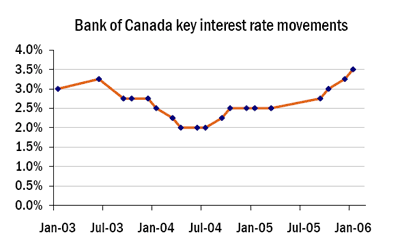
The Bank of Canada today announced in early March that it is raising its target for the overnight rate by one-quarter of one percentage point to 3 3/4 per cent. The operating band for the overnight rate is correspondingly increased, and the Bank Rate is now 4 per cent
The Bank of Canada hiked its trend-setting Bank rate in December 2005 to 3.5 per cent. The Bank began raising it in the autumn of 2004, when it stood at 2.25 per cent.
The Bank has signaled its intention to continue hiking the Bank rate, which is widely expected to rise by a further one quarter of a percentage point between now and the late spring of 2006. The Canadian Real Estate Association expects the Bank rate to top out and stabilize at 3.75 per cent by mid-year.
The Bank is concerned about the potential for renewed inflation since. This has been the banks main concern over the past 5 years or so. There is ample evidence that there is virtually no slack in Canada's product and labour markets. Canadian economic growth is forecast to be 2.9 per cent in 2006, which slighter faster than its estimated non-inflationary rate of 2.8 per cent.
Financial markets think a rising Bank rate hike will keep inflation under wraps. Since bonds respond to inflation expectations and mortgage rates track bond yields, the five-year conventional mortgage rate is expected to rise by no more than one-half of a percentage point in 2006.
At the end of 2005, the five-year conventional mortgage rate stood at 6.3 per cent with this being the posted rate. Stiff competition among mortgage lenders continues to help borrowers negotiate discounts of about one per cent or even more off the advertised rate. Higher mortgage rates are expected to only gradually cool resale housing activity in 2006 and should have an effect on the Toronto Real Estate market prices.
- If you want all the actual values of rates from 1979, I have them, and would be pleased to E-mail them to you on request. Click here to request that I send you the rates.
- I also have the average single family residential property prices going back to 1985
- You may also read about and see another graph of the mortgage interest rates
Does the Bank of Canada set all interest rates?
No. The Bank of Canada sets the "target for the overnight rate." The overnight rate is the interest rate that banks charge each other to cover their short-term daily transactions. The target for the overnight rate is a half-percentage-point band.
If, for instance, that band is 3.25 per cent to 3.75 per cent, it means that banks will charge 3.75 per cent interest on money they lend to other banks and pay 3.25 per cent interest on money deposited by other banks. A nice setup!
The chartered banks use the overnight rate as a guide in setting their prime lending rate – the rate at which the bank's best customers can borrow money. When the central bank changes its overnight rate, it's sending a signal to the chartered banks that it wants them to change their prime lending rates. The banks always follow suit; if the central bank raises its overnight rate and a bank leaves its prime rate unchanged, it will make less profit.
The Bank of Canada does not directly set mortgage rates or credit card rates. Variable mortgage rates and other floating rate loans like lines of credit move up and down in lock step with the prime lending rate. But the rates for fixed mortgages depend more on the bond market.
Banks rely on the bond market to raise money for those kinds of mortgages. Interest rates on the bond market can move up or down more frequently than the prime rate because the bond market is far more sensitive to market fluctuations. Rates move when traders believe the central bank may be about to increase – or reduce – interest rates. You can find more about this and other Bank of Canada Monetary policies at Bank of Canada. This information is mostly from cbc.ca/news
You may wish to read more at google about how the Bank of Canada sets interest rates and it's policies
If you have any questions about bank rates or mortgage rates please email me.
Thank you,
Mark










No comments:
Post a Comment